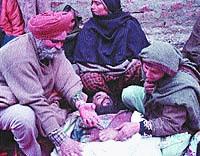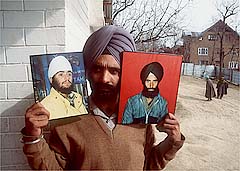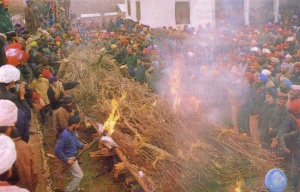Chittisinghpura Massacre: Difference between revisions
No edit summary |
No edit summary |
||
| Line 1: | Line 1: | ||
[[Image:An old couple grieves over the body of their only son.jpg|thumb|right|300px|An old couple grieves over the body of their only son]] | |||
The Chittisinghpura massacre refers to the murder of 35 adherents of the religion of [[Sikhism]] (called [[Sikh.]]s) by the Islamic Fundamentalist militant group Lashkar-e-Toiba on March,2000. | The Chittisinghpura massacre refers to the murder of 35 adherents of the religion of [[Sikhism]] (called [[Sikh.]]s) by the Islamic Fundamentalist militant group Lashkar-e-Toiba on March,2000. | ||
==The killings== | ==The killings== | ||
[[Image:Nanak_Singh_survived_the_Chittisinghpora_massacre;_his_son_and_brother_did_not..jpg|thumb|right|300px|Nanak_Singh_survived_the_Chittisinghpora_massacre;_his_son_and_brother_did_not.]] | |||
The killers were disguised in Indian Army fatigues to avoid detection. The massacre took place when the militants opened fire on the villagers, resulting in a large number of deaths. The sole survivor of the massacre was one Nanak Singh, who recounted the events to reporters.[1] | The killers were disguised in Indian Army fatigues to avoid detection. The massacre took place when the militants opened fire on the villagers, resulting in a large number of deaths. The sole survivor of the massacre was one Nanak Singh, who recounted the events to reporters.[1] | ||
| Line 8: | Line 10: | ||
==Aftermath== | ==Aftermath== | ||
[[Image:Cremation.jpg|thumb|right|300px]] | |||
The killings of 36 Sikhs was a turning point in the Kashmir issue, where Sikhs had usually been spared of militant violence. | The killings of 36 Sikhs was a turning point in the Kashmir issue, where Sikhs had usually been spared of militant violence. | ||
Revision as of 13:43, 27 July 2007
The Chittisinghpura massacre refers to the murder of 35 adherents of the religion of Sikhism (called Sikh.s) by the Islamic Fundamentalist militant group Lashkar-e-Toiba on March,2000.
The killings
The killers were disguised in Indian Army fatigues to avoid detection. The massacre took place when the militants opened fire on the villagers, resulting in a large number of deaths. The sole survivor of the massacre was one Nanak Singh, who recounted the events to reporters.[1]
The residents were killed by LeT as part of their Islamist campaign in the region. An LeT militant named Suhail Malik of Sialkot, who was arrested in December of the same year, admitted to the involvement of the group and had no regret in perpetrating the anti-Sikh massacre. Malik said he had opened fire because he had been ordered to do so by his commanders. He also said that he knew nothing about the plot to kill the Sikhs until he stood in an orchard where the 35 people were killed. Lashkar-e-Toiba had taught Malik marksmanship and mountain climbing. He sneaked into India in October 1999, with the equivalent of USD 200 in expense money, in order to participate in the massacre. [2].
Aftermath
The killings of 36 Sikhs was a turning point in the Kashmir issue, where Sikhs had usually been spared of militant violence.
The villagers ensured that the local school was up and running just two weeks after the killings. The massacre created suspicion between the Sikh and Muslim residents of the area, but no problems developed in the joint Muslim-Sikh village school.[1]
In 2005, Sikh organizations such as the Bhai Kanahiya Jee Nishkam Seva Society demanded a deeper state inquiry into the details of the massacre[3] and that the inquiry be made public. The state government ordered an inquiry into the massacre. A day after the inquiry was ordered, an NDTV special correspondent Barkha Dutt went to the village.[1]
Clinton Controversy
The massacre coincided with the visit of United States president Bill Clinton to India. In an introduction to a book written by Madeleine Albright titled The Mighty and the Almighty: Reflections on America, God, and World Affairs (2006), he accused "Hindu Militants" of perpetrating the act. The error created was a major incident, with both Hindu and Sikh groups expressing outrage at the error. Clinton's office did not return calls seeking comment or clarification. In the hours immediately after the massacre in March 2000, the US condemned the killings but refused to accept the Indian governments contention that it was the work of Pakistan based Islamist groups. That changed as soon as Clinton's error was exposed. The publishers, Harper Collins routed a correction through Albright's office. In a public statement they acknowledged the error.[4]
Page xi of the Mighty and the Almighty contains a reference to Hindu militants that will be deleted in subsequent printings, both in America and in international editions. This error was due to a failure in the fact-checking process.[4]
Mishra Controversy
The apparent error was aggrandized by Clinton's refusal to acknowledge it, and exacerbated by Pankaj Mishra's book Temptations of the West: How to be Modern in India, Pakistan, Tibet and Beyond where he repeated the allegations against Hindus even after the confession of the Lashkar-e-Toiba militant[5].
Chittisinghpura massacre in film
The massacre was depicted in the commercial Bollywood film Adharm (unholy) directed by Adeep Singh.
External links
AMNESTY INTERNATIONAL - India: A trail of unlawful killings in Jammu and Kashmir: Chithisinghpora and its aftermath



